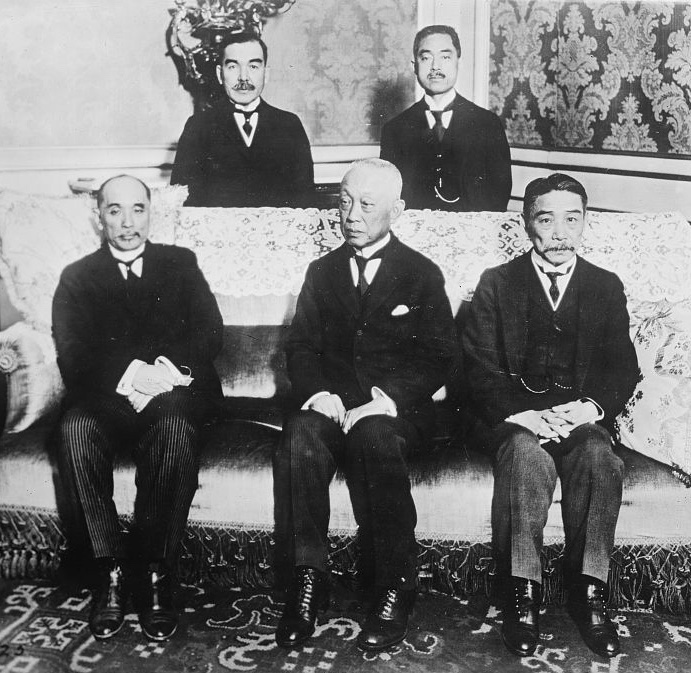Ijūin Hikokichi on:
[Wikipedia]
[Google]
[Amazon]
Ijūin Hikokichi (伊集院 彦吉, ''Ijūin Hikokichi''; 22 July 1864 – 26 April 1924) was a Japanese diplomat and politician who served as
 Prime Minister
Prime Minister
minister of foreign affairs
A foreign affairs minister or minister of foreign affairs (less commonly minister for foreign affairs) is generally a cabinet minister in charge of a state's foreign policy and relations. The formal title of the top official varies between cou ...
and Japanese ambassador to Peking
}
Beijing ( ; ; ), alternatively romanized as Peking ( ), is the capital of the People's Republic of China. It is the center of power and development of the country. Beijing is the world's most populous national capital city, with over 21 ...
.
Early life
Ijūin was born on 22 July 1864, in Kōrai,Kagoshima
, abbreviated to , is the capital city of Kagoshima Prefecture, Japan. Located at the southwestern tip of the island of Kyushu, Kagoshima is the largest city in the prefecture by some margin. It has been nicknamed the "Naples of the Eastern wor ...
, Satsuma Domain
The , briefly known as the , was a domain (''han'') of the Tokugawa shogunate of Japan during the Edo period from 1602 to 1871.
The Satsuma Domain was based at Kagoshima Castle in Satsuma Province, the core of the modern city of Kagoshima, ...
, the eldest son of samurai
were the hereditary military nobility and officer caste of medieval and early-modern Japan from the late 12th century until their abolition in 1876. They were the well-paid retainers of the '' daimyo'' (the great feudal landholders). They h ...
Ijūin Kichitsugu.
Career
Ijūin was appointed consul atChefoo
Yantai, formerly known as Chefoo, is a coastal prefecture-level city on the Shandong Peninsula in northeastern Shandong province of People's Republic of China. Lying on the southern coast of the Bohai Strait, Yantai borders Qingdao on the ...
in China in 1893. He served again in China as consul general at Tientsin
Tianjin (; ; Mandarin: ), alternately romanized as Tientsin (), is a municipality and a coastal metropolis in Northern China on the shore of the Bohai Sea. It is one of the nine national central cities in Mainland China, with a total popul ...
from 1901 to 1907. He was appointed ambassador to Peking in 1908. On 4 September 1909, he signed the Japan-China Agreement concerning Kando as the Japanese ambassador to the Ching Empire in Peking. During the Chinese Revolution broke out in October 1911, together with then Foreign Minister Uchida Yasuya, he argued for the provision of support to the Ching government. His term as ambassador to China lasted until 1913.
Then, Ijūin was appointed the Japanese ambassador to Italy in 1916 and was in office until 1920. During his tenure, he was one of the leading members of Japanese delegation at the Paris Peace Conference in 1919. Ijūin is described as a conservative ambassador.
 Prime Minister
Prime Minister Hara Takashi
was a Japanese politician who served as the Prime Minister of Japan from 1918 to 1921.
Hara held several minor ambassadorial roles before rising through the ranks of the Rikken Seiyūkai and being elected to the House of Representatives. Har ...
wanted Ijūin to search for European institutions of public information when the latter was ambassador and a Versailles delegate. Ijūin reported that the best way to create an influential information bureau was to coordinate all information sources, including army, navy and finance ministry. Eventually, a public information office, Gaimu-shō Jōhō-bu, in the ministry of foreign affairs was established on 13 August 1921, and Ijūin was appointed its head. Then he served as governor-general of Kwantung Leased Territory
The Kwantung Leased Territory ( ja, 關東州, ''Kantō-shū''; ) was a leased territory of the Empire of Japan in the Liaodong Peninsula from 1905 to 1945.
Japan first acquired Kwantung from the Qing Empire in perpetuity in 1895 in the Trea ...
in northeastern China for one year. He was appointed to the post on 8 September 1922, replacing Isaburō Yamagata. Ijūin was in office until 19 September 1923.
Ijūin was appointed minister of foreign affairs on 19 September 1923 to the second cabinet of Yamamoto Gombee, replacing him who also assumed the role of foreign minister briefly from 2 to 19 September. Ijūin was replaced by Keishirō Matsui on 7 January 1924 when a new cabinet was formed by Kiyoura Keigo
Count was a Japanese politician. He was the Prime Minister of Japan in 1924, during the period which historians have called the " Taishō Democracy".
Early life
Kiyoura was born Ōkubo Fujaku in Kamoto, Higo Province (part of present-day ...
.
Personal life and death
Ijūin was married toŌkubo Toshimichi
was a Japanese
statesman and one of the Three Great Nobles regarded as the main founders of modern Japan.
Ōkubo was a ''samurai'' of the Satsuma Domain and joined the movement to overthrow the ruling Tokugawa Shogunate during the ''Bak ...
's daughter, Yoshiko. Thus, he was the brother-in-law of Makino Nobuaki
Count was a Japanese politician and imperial court official. As Lord Keeper of the Privy Seal of Japan, Makino served as Emperor Hirohito’s chief counselor on the monarch’s position in Japanese society and policymaking. In this capacity, he ...
.
Shortly after his removal from the office, Ijūin died of neuralgia
Neuralgia (Greek ''neuron'', "nerve" + ''algos'', "pain") is pain in the distribution of one or more nerves, as in intercostal neuralgia, trigeminal neuralgia, and glossopharyngeal neuralgia.
Classification
Under the general heading of neuralg ...
in Tokyo in April 1924.
References
External links
* {{DEFAULTSORT:Ijuin, Hikokichi 20th-century Japanese diplomats 20th-century Japanese politicians 1864 births 1924 deaths Ambassadors of Japan to China Ambassadors of Japan to Italy Foreign ministers of Japan Japanese colonial governors and administrators People of the Kwantung Leased Territory